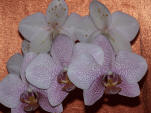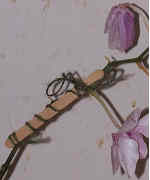The Scale of House Plants
The Phalaenopsis pictured right was given to me about 2 and 1/2 years ago. It has been extraordinarily beautiful in flowering 2 times a year - in April-June and again October to Christmas. Each time the flowers are long lasting.
The picture shows a truss of 6 flowers - 3 facing camera and 3 facing away. But take a close look at the petals facing away (upper most in the picture). Those spots are not made for insects approaching the wrong way. No, they are not petal blotches, but scale insects.
Scale insects are small brown shield shaped creatures that suck sap. This plant has been afflicted by them since I got it. But until now I've only noticed them on the leaves. The treatment is to gently rub them off with finger and thumb. They come off quite easily. You could use a damp cloth. Some gardeners recommend methylated spirit or soap, but I don't think chemicals are necessary as they come off easily. Anyway, I won't be de-scaling the petals of these beautiful flowers until they wilt. I will keep a close organic gardener's eye on it to ensure the infestation doesn't spread to other plants and is kept well in check.
Brief Note on Phalaenopsis Cultivation
Phalaenopsis was supplied in a transparent plastic pot packed full of fleshy root like growths with a silvery skin and rooted in some kind of bark mixture. I only water it seldomly, every 2 weeks and, often far less in fact. Certainly don't over water, and except for a few drops at the bottom that should be absorbed quickly, don't leave immersed in water.
The roots green up down below (hence the transparent pot to let light in) and I think they may contain nitrogen fixing microorganisms. The plant has lost 1 or 2 leaves per year so far but it grows new ones. Before shedding, these old leaves are drained of all green and they turn yellow and dry as a husk. I think Phalaenopsis is able to re-absorb the vast majority of nutrient from the old leaves and re-cycle them to new leaves. So don't cut them off prematurely - this may be the reason why most Phalaenopsis only flower once a year. It seems that the plant doesn't need much in the way of food. Except for stuffing the dried up dead leaves into the outer container I've not fed it.
All told this is one of the most delightful house plants that I could recommend to the novice organic gardener.
A Splint To Repair Damage The flower stem grows horizontally if left alone. This is not the best position for displaying the flowers. Therefore, at an early stage while the flower stem is young and supple, tie it to an upright stick.
The flower stem grows horizontally if left alone. This is not the best position for displaying the flowers. Therefore, at an early stage while the flower stem is young and supple, tie it to an upright stick.
In the example pictured here the flower stem began leaning badly and I fixed a splint made from a wooden lolly pop stick to help straighten it again.
Sunday, December 11, 2005
Subscribe to:
Post Comments (Atom)
No comments:
Post a Comment